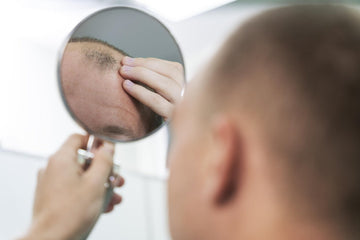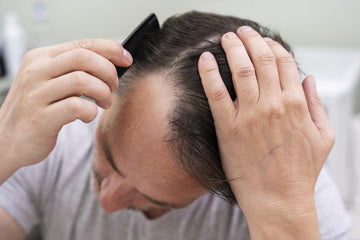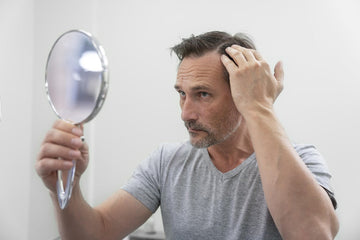Does Minoxidil Cause Hair Loss or Help?

Marinella Helera • Aug 04, 2025
Many people get confused when they see more hair falling out after starting minoxidil. This can be confusing, as the treatment is designed to regrow hair, not cause it to fall out.
However, this early shedding is part of how the treatment works. As new hairs begin to grow, the old ones get pushed out. That can make it appear as though things are getting worse, but it usually means the product is working effectively.
In this blog, we will discuss "Can minoxidil cause hair loss?", when it’s normal, and what to do next.
What Is Minoxidil and How Does It Work?
Minoxidil is an FDA-approved topical treatment used to manage hair loss. It is widely known under the brand name Rogaine. This medication works by improving blood flow to the scalp. Better circulation helps nourish the hair follicles and supports their growth cycle.
It also extends the anagen phase, which is the active stage where hair grows. As a result, more follicles stay in this phase longer, allowing for thicker and fuller hair over time. Minoxidil is often used for male pattern baldness, but some women also benefit from its use under medical guidance.
Can Minoxidil Cause Hair Loss?
Yes, minoxidil can cause hair loss at the start, but this is usually temporary. According to experts, during the first 2-8 weeks, many users notice increased shedding. This happens because the hair shifts from the resting (telogen) phase to the growing (anagen) phase.
As new hairs start to grow, old ones are pushed out and fall. This process is expected and usually short-lived. For most users, shedding stops once the scalp adjusts to the treatment.
Why Does Minoxidil Shedding Happen?
Many people are surprised to see more hair fall out after starting minoxidil, but this reaction is expected. Minoxidil shedding is a normal part of how the treatment begins to work and usually means the hair follicles are responding.
1. Hair Cycle Resetting
Minoxidil pushes dormant hairs out of the scalp to make room for new ones. These hairs are already near the end of their life cycle. Shedding starts as the follicles move from the resting phase to the growing phase.
2. Increased Blood Flow to Follicles
The treatment improves circulation in the scalp. As blood flow increases, weakened or miniaturized hairs are forced out. This clears space for healthier, thicker strands to grow in their place.
3. Normal Part of Treatment
Shedding is part of how minoxidil works. It shows the follicles are responding and beginning a new growth cycle.
How Long Does Minoxidil Shedding Last?
The shedding phase can be unsettling, but it usually does not last long. With regular use, most people move past this stage within a few weeks.
Minoxidil shedding usually lasts between two and six weeks. In some cases, it may continue for up to three months. New growth typically appears between the third and sixth month of consistent use after shedding slows.
When Is Shedding a Red Flag?
Shedding after starting minoxidil is common, but it should improve with time. If hair continues to fall out after three or four months, it may signal that something else is going on. That’s especially true if the hair loss becomes patchy or if bald spots appear.
Another warning sign is scalp irritation that does not go away. Redness, flaking, or burning may point to sensitivity or a reaction to the product. In some cases, the hair loss may worsen rather than stabilize, which should not be ignored.
If any of these signs appear, it’s a good idea to speak with a doctor. While minoxidil helps many people, it may not be right for everyone. Taking care of your scalp is important for its health. You can support it by eating well, being gentle with your hair, and using the right products.
Spartan’s supplements and treatments are gentle on your scalp and offer a complete plan to care for your hair during treatment.
Common Side Effects of Minoxidil
Minoxidil may cause side effects beyond shedding, especially when used over time. One common reaction is dryness or irritation on the scalp. Some people notice flaking, which may look like dandruff.
Itching is also possible, especially during the early weeks. These effects often improve with regular use, but they can be uncomfortable. If the solution drips onto the face or neck, it can cause unwanted hair growth in those areas.
Additionally, one might also be allergic to minoxidil. Though rare, an allergic reaction might occur. Signs include redness, swelling, or a rash. If any of these symptoms happen, stop using the product and seek medical advice.
To reduce irritation, use a gentle shampoo and avoid harsh hair products. A calming serum or scalp treatment may help soothe dryness. Spartan offers mild, scalp-supportive formulas in the form of shampoo that can be a helpful part of your hair care routine during treatment.
How to Manage and Minimize Shedding
Shedding during the early phase of minoxidil use can be stressful, but there are ways to manage it effectively. Instead of stopping treatment, it’s more helpful to understand how to support your hair and scalp during this period. These practical steps can reduce discomfort and encourage healthier growth:
1. Stay Consistent
The first and most important step is to keep using minoxidil consistently. Stopping during the shedding phase often leads to even more hair loss. That’s because stopping treatment interrupts the hair cycle and can trigger a fresh round of shedding. Apply the product as directed, once or twice daily, so the follicles stay active and continue transitioning into the growth phase.
2. Support with Nutrition and Supplements
Hair growth is influenced by what the body receives from within. Nutrients such as biotin, zinc, vitamin D, and saw palmetto are essential for maintaining follicle health. A balanced diet is beneficial, but supplements can provide additional support when necessary. Incorporating the right nutrients consistently bridges the gap between diet and follicle health. Spartan’s hair growth range aims to deliver nutrients in effective amounts, making them a helpful addition to your routine.
3. Use a Gentle Hair Care Routine
A harsh routine can worsen shedding. Tight hairstyles, frequent heat styling, and products with strong chemicals can strain the scalp and weaken hair. Instead, use a mild shampoo and avoid pulling the hair tightly. Let your hair dry naturally and use wide-tooth combs to prevent breakage during this sensitive time.
4. Combine with Other Treatments
Minoxidil works well on its own, but results can improve when combined with DHT blockers and gentle shampoos. Products that target hormonal causes of hair loss, like Spartan’s Root Activator products, offer a more complete approach. Using these together may help reduce shedding and promote stronger, longer-lasting regrowth.
Can Minoxidil Cause Permanent Hair Loss?
Many people worry that the shedding caused by minoxidil may lead to permanent hair loss. However, this type of hair fall is temporary and does not damage the follicles. In fact, it is a normal part of how the treatment starts to work.
Minoxidil pushes old hairs out to make space for new ones. This shedding phase may feel like a setback, but it is usually a sign that hair growth is beginning. Permanent hair loss is more likely to happen if the treatment is stopped suddenly, especially after using it for a long time.
Other causes of lasting hair loss may include medical conditions or hormonal imbalances, not the medication itself. If shedding continues beyond a few months, it is best to consult with a doctor. With regular use and proper care, most people see positive changes without any long-term damage.
How to Know If Minoxidil Is Working
To know if minoxidil is working, you need to be patient and watch closely. In the first few weeks, you might see more hair falling out. This can be confusing, but it often means that the medication is starting to activate hair follicles.
By the third or fourth month, many people notice less hair loss. This is usually followed by the growth of short, thin baby hairs in areas that were thinning. Over time, these hairs can become thicker and stronger.
Changes may happen slowly, so it's important to stay consistent and patient. Most people see fuller hair growth after using it for six months or more.
Take photos to track your progress and compare them each month so you can have a better idea of changes that are hard to see day by day.
Spartan’s Role in Supporting Hair Growth
Hair growth does not rely on a single solution. While treatments like minoxidil stimulate growth from within the follicle, scalp health also matters. Spartan’s Root Activator line is designed to work alongside minoxidil by keeping the scalp clean, nourished, and balanced. This helps create a better environment for regrowth and reduces stress on thinning hair.
Spartan Root Activator Shampoo
This shampoo uses a blend of plant-based ingredients to support the scalp and hair from the root. They help cleanse the scalp with their natural antimicrobial properties. It removes buildup from follicles, which can block growth. It includes peppermint and menthol, which improve blood circulation at the scalp. This helps hair roots absorb nutrients more effectively, especially when combined with other treatments.
In addition, the formula features Biota Orientalis Leaf, Polygonum Multiflorum Root, and Eclipta Prostrata Extract. These ingredients deliver targeted nutrients that support the natural shift from shedding to growth. When the scalp receives steady nourishment, hair follicles are more likely to stay in the growth phase longer.
Spartan Root Activator Conditioner
The conditioner works to hydrate, strengthen, and calm the scalp. It nourishes follicles at the root while improving overall softness and manageability. Ingredients in the formula also help exfoliate dry skin, clear pores, and reduce surface stress that can affect growth. With regular use, hair feels stronger and looks healthier.
Spartan Root Activator Spray
This leave-in spray offers daily support without adding weight or residue. It delivers targeted nutrients that help maintain scalp balance and reinforce the hair at its base. The spray can be used alongside minoxidil and fits easily into any routine.







